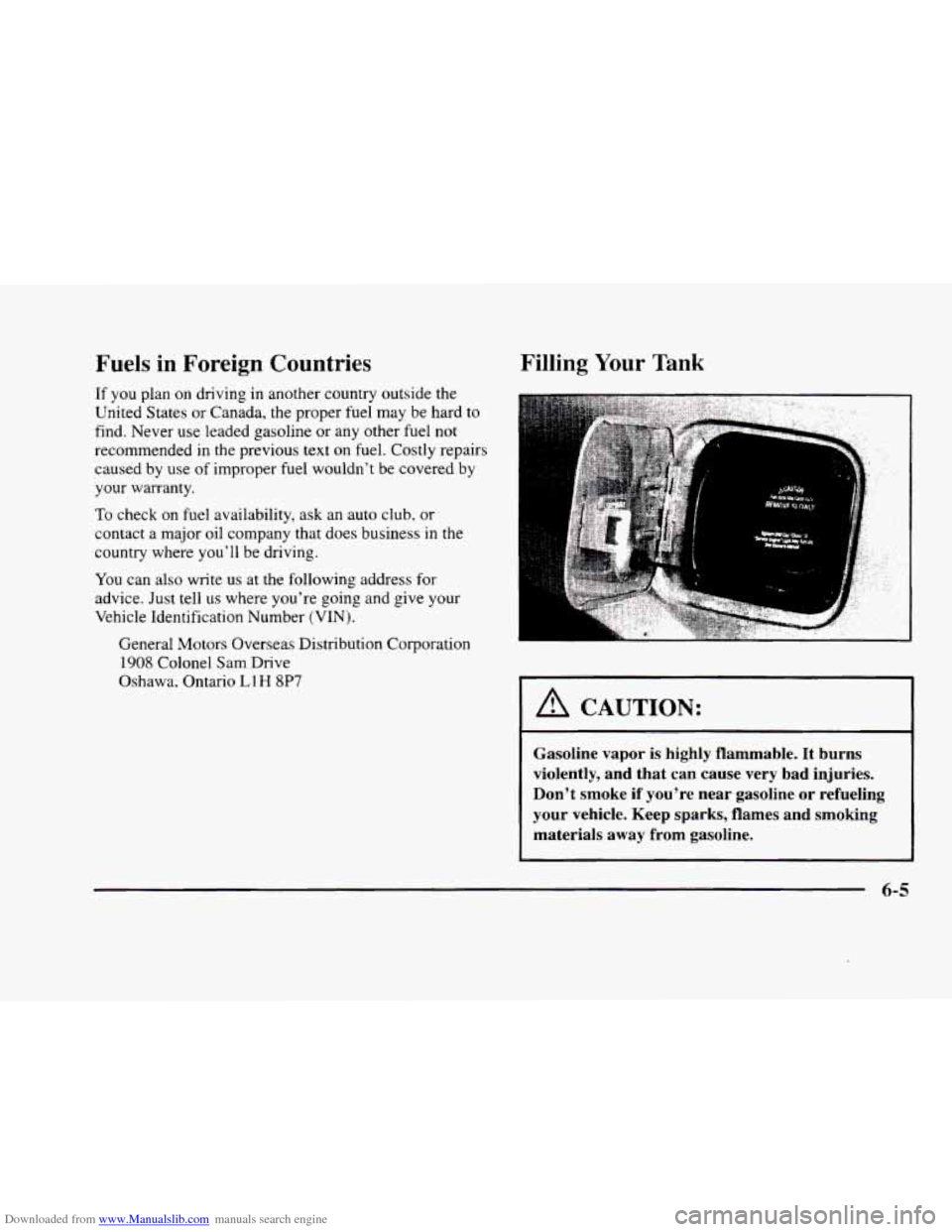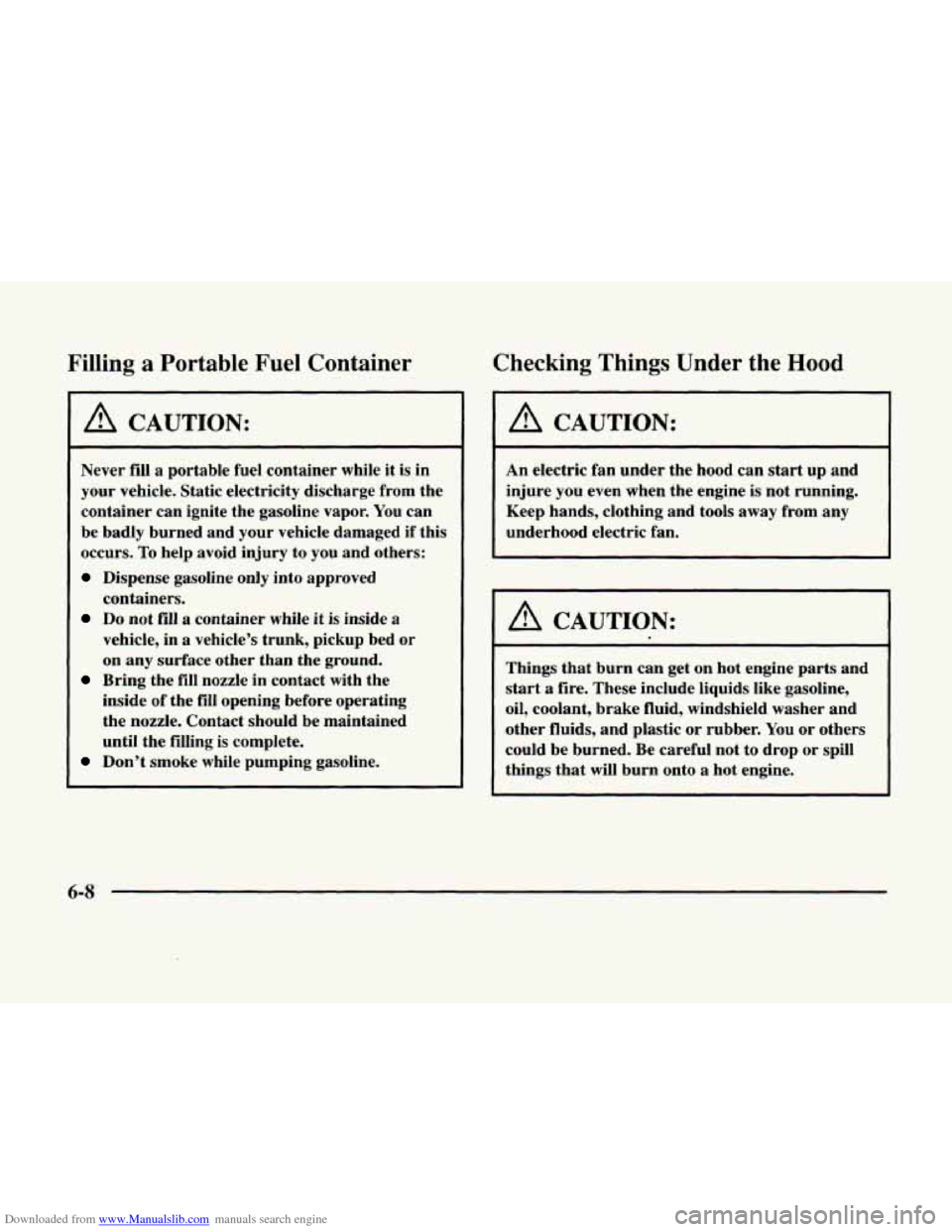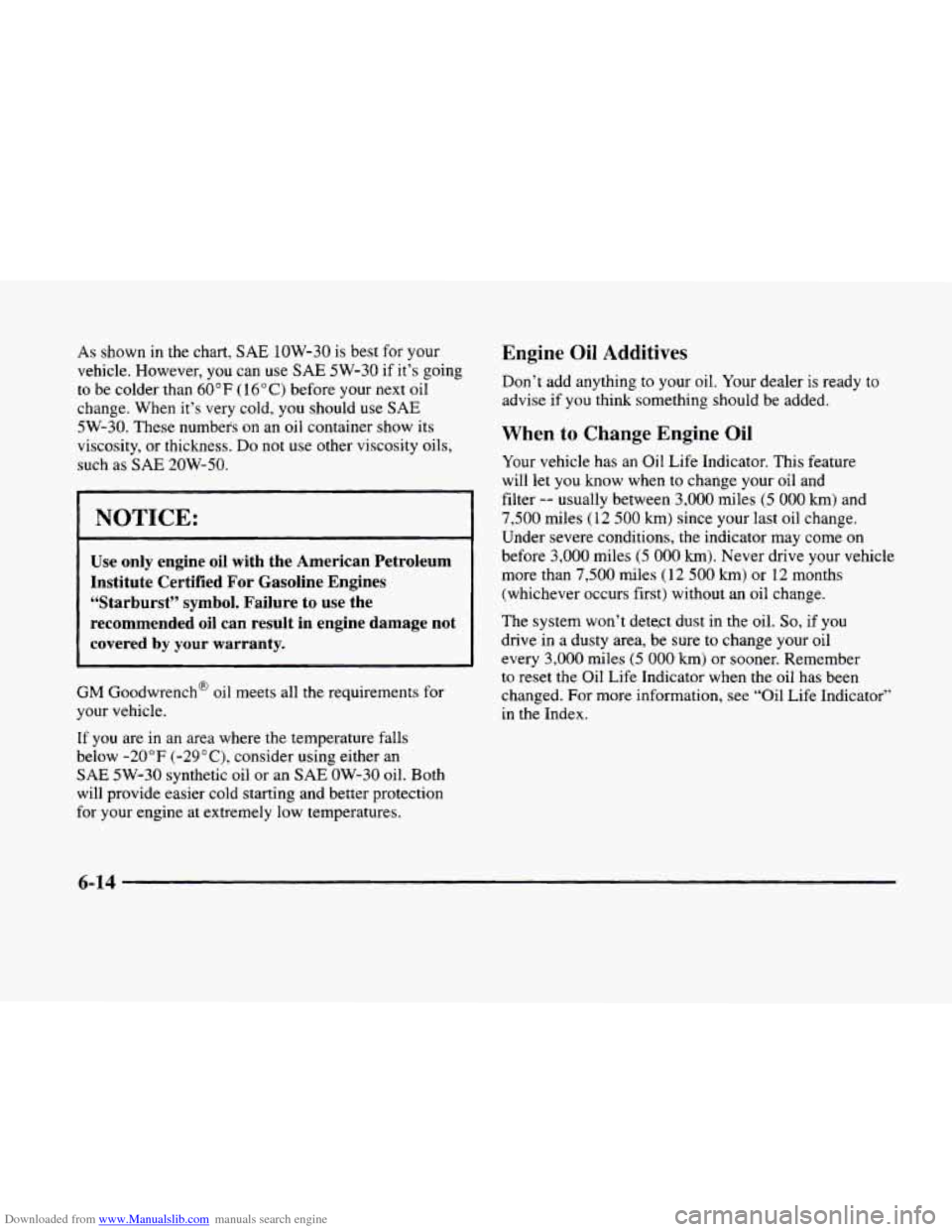Page 281 of 380

Downloaded from www.Manualslib.com manuals search engine ,<+ --\,
Section 6 Service and Appearance Care
Here you will find information about the care of your vehicle. This section begins with service and fuel infomation,
and then it shows how
to check important fluid and lubricant levels. There is also technical information about your
vehicle, and a part devoted to its appearance care.
6-2
6-3
6-5
6-8
6-8
6-1 1
6- 15
6-18
6-22
6-26
6-28
6-3 1
6-32
6-38
6-3 8
6-47
6-47
6-49 Service
Fuel
Filling Your Tank
Filling a Portable Fuel Tank
Checking Things Under the Hood
Engine Oil
Air Cleaner
Automatic Transaxle Fluid
Engine Coolant
Windshield Washer Fluid
Brakes
Battery
Bulb Replacement
Windshield Wiper Blade Replacement
Tires Appearance Care
Cleaning the Inside
of Your Vehicle
Care
of Safety Belts 6-50
6-50
6-50
6-50
6-52
6-52
6-52
6-53
6-5
3
6-54
6-55
6-55
6-64
6-64
6-65
6-65 Cleaning
Glass Surfaces
Cleaning the Outside of the Windshield and
Wiper Blades
Weatherstrips
Cleaning the Outside
of Your Vehicle
Cleaning Aluminum or Chrome Wheels
(If Equipped)
Cleaning Tires
Sheet Metal Damage
Underbody Maintenance
Chemical Paint Spotting
Appearance Care Materials Chart
Vehicle Identification Number (VIN)
Electrical System
Replacement Bulbs Capacities and Specifications
Air Conditioning Refrigerants
Normal Maintenance Replacement
Parts
6-1
Page 285 of 380

Downloaded from www.Manualslib.com manuals search engine Fuels in Foreign Countries
If you plan on driving in another country outside the
United States
or Canada, the proper fuel may be hard to
find. Never use leaded gasoline or any other fuel not
recommended
in the previous text on fuel. Costly repairs
caused by use
of improper fuel wouldn’t be covered by
your warranty.
To check on fuel availability, ask an auto club, or
contact a major oil company that does business in the
country where you’ll be driving.
You can also write us at the following address for
advice. Just tell us where you’re going and give your
Vehicle Identification Number (VN).
General Motors Overseas Distribution Corporation
1908 Colonel Sam Drive
Oshawa, Ontario
Ll H 8P7
Filling Your Tank
. ..
. ‘7
1 A CAUTION:
Gasoline vapor is highly flammable. It burns
violently, and that
can cause very bad injuries.
Don’t smoke if you’re near gasoline or refueling
your vehicle. Keep sparks, flames and
smoking
materials away from gasoline.
6-5
Page 288 of 380

Downloaded from www.Manualslib.com manuals search engine Filling a Portable Fuel Container
A CAUTION:
Never fill a portable fuel container while it is in
your vehicle. Static electricity discharge from the
container can ignite the gasoline vapor. You can
be badly burned and your vehicle damaged if this
occurs.
To help avoid injury to you and others:
Dispense gasoline only into approved
containers.
Do not fill a container while it is inside a
vehicle, in a vehicle’s trunk, pickup bed or
on any surface other than the ground.
inside of the
fill opening before operating
the nozzle. Contact should be maintained
until the filling is complete.
Bring the fill nozzle in contact with the
Don’t smoke while pumping gasoline.
Checking Things Under the Hood
A CAUTION:
An electric fan under the hood can start up and
injure you even when the engine is not running.
Keep hands, clothing and tools away from
any
underhood electric fan.
A CAUTION:
Things that burn can get on hot engine parts and
start a fire. These include liquids like gasoline,
oil, coolant, brake fluid, windshield washer and
other fluids, and plastic or rubber. You or others
could be burned. Be careful not to drop or spill
things that will burn onto a hot engine.
6-8
Page 290 of 380
Downloaded from www.Manualslib.com manuals search engine A. Battery D. Oil
Fill Location G. Transaxle DipsticWluid
B. Coolant Fill Location E. Engine Oil Dipstick Location Fill Location
C. Power
Steering Fluid E Brake Master Cylinder H. Air Cleaner
Before
closing the hood, be sure all filler caps are on properly. Then pull the hood down and close it firmly.
I. Windshield Washer Fluid
6-10
Page 291 of 380

Downloaded from www.Manualslib.com manuals search engine Underhood Lamp
Turn the parking lamps on to operate the underhood
lamp.
The underhood lamp will come on when the
hood is opened.
Engine Oil
1
iMlUM UNLEADED
FUEL ONLY TRIP fl fl.
@BMaBUD
.......................... .............. ....... ............ ....... .... ..... ........... ... ....... :;if i i.. *: :-i.. : i : ......................................... .".......
1 CHECK OIL LEVEL message will appear when the
engine oil is approximately
1 quart (1 L) low. If the
message is displayed, check the dipstick level and add
oil
as needed.
It's a good idea to check your engine oil every time you
get fuel. In order to get an accurate reading, the oil must
be warm and the vehicle must be on level ground.
The engine oil dipstick is
located behind
the radiator
on the driver's side of the
engine. The black handle
says ENGINE OIL on it.
Turn off the engine and
give
the oil a few minutes
to drain back into the oil
pan.
If you don't, the oil
dipstick might not show
the actual level.
6-11
Page 292 of 380
Downloaded from www.Manualslib.com manuals search engine Checking Engine Oil
Pull out the dipstick and clean it with a paper towel or
cloth, then push it back in all the way. Remove
it again,
keeping the tip down, and check the level.
When to Add Engine Oil
If the oil is at or below the ADD line, then you’ll need
to add at
least one quart of oil. But you must use the
right kind. This part explains what kind of oil to use. For
crankcase capacity,
see “Capacities and Specifications”
in the
Index.
NOTICE:
Don’t add too much oil. If your engine has so
much oil that the oil level gets above the upper
mark that shows the proper operating range,
your engine could be damaged.
A
The oil fill cap is located
behind the radiator
on the
passenger’s side
of the
engine.
Turn the cap to the
left to remove it.
Be sure to
fill it enough to put the level somewhere in
the proper operating range. Push the dipstick all the way
back in when you’re through.
6-12
Page 293 of 380
Downloaded from www.Manualslib.com manuals search engine What Kind of Engine Oil to Use
Oils recommended for your vehicle can be identified by
looking for
the "Starburst" symbol. This symbol
indicates that
the oil has been certified by the American
Petroleum Institute
(API). Do not use any oil which
does
not carry this Starburst symbol.
If you change your own
oil, be
sure you use oil that
has the Starburst symbol
on the front of the oil
container. If you have your
oil changed for you,
be sure
the oil put into your engine
is American Petroleum
Institute certified for
gasoline engines.
I .I I
You should also use the proper viscosity oil for your
vehicle, as shown in the following
chart:
RECOMMENOED SAL VISCOSITY GRADE ENGINE OILS
FOR BEST FUEL ECONOMY AND COLD STARTINB, SELECT T&-LOWEST
SAE
VISCOSITY GRADE OIL FOR THE EXPECTED TEMPERATURE RANGE. -. I
HOT
WEATHER
I- SAE I 1OW-30
PREFERRED abovo QF (- 18%)
DO NOT USE SA€ 20W-50 OR ANY OTHER GRADE OIL NOT RECOMMENDED
6-13
Page 294 of 380

Downloaded from www.Manualslib.com manuals search engine As shown in the chart, SAE 1OW-30 is best for your
vehicle. However,
you can use SAE 5W-30 if it’s going
to be colder than
60°F (16°C) before your next oil
change. When it’s very cold, you should use
SAE
5W-30. These numbers on an oil container show its
viscosity, or thickness.
Do not use other viscosity oils,
such as SAE 20W-50.
NOTICE:
Use only engine oil with the American Petroleum
Institute Certified For Gasoline Engines
“Starburst”
symbol. Failure to use the
recommended oil can result in engine damage not
covered
by your warranty.
GM Goodwrench@ oil meets all the requirements for
your vehicle.
If you are in an area where the temperature falls
below
-20°F (-29”C), consider using either an
SAE 5W-30 synthetic oil or an SAE OW-30 oil. Both
will provide easier cold starting and better protection
for your engine at extremely low temperatures.
Engine Oil Additives
Don’t add anything to your oil. Your dealer is ready to
advise if
you think something should be added.
When to Change Engine Oil
Your vehicle has an Oil Life Indicator. This feature
will let
you know when to change your oil and
filter
-- usually between 3,000 miles (5 000 km) and
7,500 miles (12 500 km) since your last oil change.
Under severe conditions, the indicator may come on
before
3,000 miles (5 000 km). Never drive your vehicle
more than
7,500 miles (12 500 km) or 12 months
(whichever occurs first) without an oil change.
The system won’t dete.ct dust in the
oil. So, if you
drive in
a dusty area, be sure to change your oil
every
3,000 miles (5 000 krn) or sooner. Remember
to reset the Oil Life Indicator when the oil has been
changed. For more information, see “Oil Life Indicator”
in the Index.
6-14